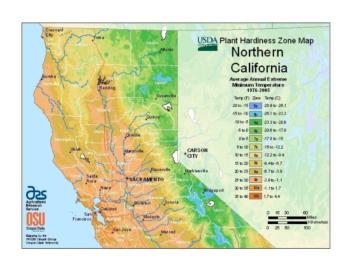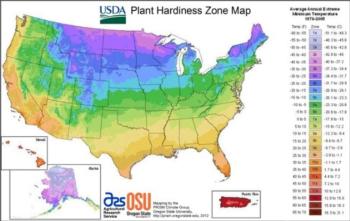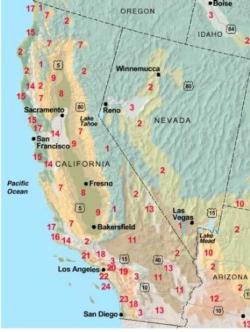Tahoe Friendly Garden: Planting Zones in Lake Tahoe
 Tahoe Friendly Garden Resources
Tahoe Friendly Garden Resources
Planting Zones in Lake Tahoe

Most gardening books, catalogs, and seed packets refer to plant hardiness zones, climate zones, or growing zones. Temperature hardiness climate zones are based on normally expected high and low temperatures and serve as guides to help you know which plants will grow where you live. Temperature is not the only factor in figuring out whether a plant will survive in your garden. Soil types, rainfall, day length, wind, humidity, and heat also play their roles. Even within a city, a street, or a spot protected by a warm wall in your own garden, there may be microclimates that affect how plants grow. The zones are only a guide and a good starting point, but you still need to determine for yourself what will and won't work in your garden.

Gardeners in the western United States sometimes are confused when confronted with the 11 Hardiness Zones created by the USDA, because we are used to a 24-zone climate system created by Sunset Magazine. The Sunset zone maps, considered the standard gardening references in the West, are more precise than the USDA's, since they factor in not only winter minimum temperatures, but also summer highs, lengths of growing seasons, humidity, and rainfall patterns. In Lake Tahoe, we are mostly in Sunset zones 2B (all of the California side) and 1A (sections of the Nevada side). Refer to the new Sunset Western Garden Book. Hardiness zones remove some of the mystery of gardening by allowing a gardener to know at a glance whether a plant will survive winter cold in his or her part of the country. So they're both empowering and budget-conscious, since these zones can help stop you from buying plants that won't survive from year to year.
|

|

|
While hardiness and heat zones are extremely helpful, they don't tell the whole story. There are many other weather effects that can determine how well a plant will grow for you, including humidity, rainfall and wind. The hardiness zones maps were compiled based on average temperatures, so they don't account for unusual weather patterns, such as temperatures hitting the single digits on Halloween night or 59 degrees in January as we have seen in Lake Tahoe. Nor is the hardiness zone map an assurance that winter temperatures will never be colder than what's stated on the map. Other factors that can't be included on a large national map are the effects of soil and soil fertility, and the health of your plants in general. Zone maps also don't tell us about microclimates, which are small areas with different weather. A good example of a microclimate is a mountain. The largest microclimate would be the whole mountain, which has different weather based on elevation, but smaller microclimates are the north and south sides of the mountain. Next might come wind-sheltered pockets on the south side or areas beside a mountain stream. Finally, a very small microclimate might be the north side of your house or a south facing brick wall. Several microclimates can exist in one place, with one adding to or cancelling out the effect of another. How can you tell if you have a microclimate where you live? Take your own temperature readings around your yard. Or use your plants as a guide: If certain plants that are supposed to be hardy to your zone continue to die in your yard, you may have a cold pocket. Or if you're growing a Zone 8 plant in Zone 7, you may have a warm pocket.
References:
http://cagardenweb.ucanr.edu/Your_Climate_Zone/
http://planthardiness.ars.usda.gov/PHZMWeb/#
https://www.sunset.com/garden/climate-zones/sunset-climate-zones-california-nevada
